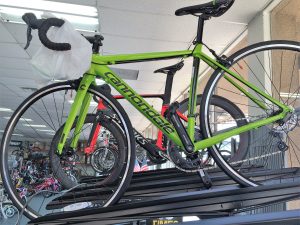
Keeping the “Rubber Side Down,” is a common expression used by motorcyclists and bicyclists alike simply put, it means that you want to avoid having an accident; ride safely!
Tire maintenance has never been a sexy topic of discussion, however, it’s critical in staying safe. Hazards of riding or driving on bad tires can cause serious injury, or worse. While you may have a state of the art carbon fiber bike with all the bells and whistles, best bike computer, highest rated cycling attire, most aerodynamic helmet, if you are riding on bad tires you are headed for trouble and no one wants that! Remember that bike tires naturally lose air, so it’s important to inflate tire pressure before every ride.
Tread Wear. Bicycle tires don’t usually offer any specific mileage warranty, which is another important reason to examine your tires before every ride. What to look for; side wall damage, threads hanging off the tires, punctures – however small, and look for a flattened appearance on the center of the tire. If you have a puncture, and the tire is not flat, you might think you are good to go, however, be aware that if that hole gets larger as you ride, the tube may be forced through the puncture causing it to explode as you ride, resulting in an immediate flat after exploding with a loud bang. As with cars, sidewall damage is not repairable. Also, consider rotating your bike tires as a car driver does for better wear. Most of your weight rides on the rear tire, so the rear tire will typically wear faster than the front tire. If you have a question about punctures or bike tire rotation check with your local bike shop.
Spare tube. Always carry a spare tube with means to inflate, (CO2 cartridge or small hand pump) as well as tire levers and patch kit. If you don’t have a tire patch kit, a great temporary fix if out riding and nowhere near a bike shop, fold a dollar bill and insert between your tube and tire. If you ride often enough you will eventually get a flat, so be prepared, it could be a long walk home. If you park your bike and don’t ride for awhile, maintain your air pressure or you may have to replace your tubes and tires as they naturally deflate, become brittle, then crack from non-use. If you have had a flat and used CO2 to inflate, deflate your tire then re-inflate with air from your pump when you get home.
Size matters. The larger the tire, the more comfortable the ride. Your bicycle manufacturer provides a recommended tire/tube replacement size for your bike. If you don’t know what size replacement you need, your local bike shop will be able to assist you. Many road bike riders use 23cc size tires. In light of a study showing that road bikes could get better road traction from a 25cc tire, (larger tire), many cyclists changed to the later recommendation for better traction. It makes sense that a larger tire would provide more surface for better traction as well as being a more comfortable ride.
Valve Types. There are two types of valves on bicycle tires; Shrader and Presta. While Presta valves are tall and narrow, accommodating higher tire pressure, and used exclusively on road bikes, Shrader valves are short and wide like a car tire valve, found on all other types of bicycles, e.g., mountain bikes, beach cruisers, etc. Some people find it difficult to inflate Presta valves, however, you may have a tire pump that is simply worn out. Many bike tire pump manufacturers offer warranties, so keep your receipt for proof of purchase.
Tire pressure. All tires have a recommended inflation (PSI – Pounds Per Square Inch), which is well marked on the sidewall of your tire. Never overfill your tire pressure more than the manufacturers recommended psi. Bike shops typically fill the rear road bike tire to capacity, e.g., 120 psi (see your side wall for your tire mfg. recommendation), while the front tire sidewall calls for 120 psi, fill instead to a lesser capacity, e.g. 110 psi. Your tire pressure affects your ride; more air, firmer ride, bigger tire more comfortable ride. When purchasing a bike tire pump, consider the flexibility of a pump that will allow inflation for either type of valve.
Now check your tire pressure, inflate, and enjoy your ride!
Women Bicycling Logo is a Registered Trademark

